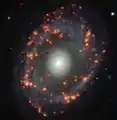| NGC 6902 | |
|---|---|
 NGC 6902 taken by SPECULOOS.[1] | |
| Observation data (J2000[2] epoch) | |
| Constellation | Sagittarius |
| Right ascension | 20h 24m 28.0654195725s[2] |
| Declination | −43° 39′ 12.429965263″[2] |
| Redshift | 0.009363[2] |
| Heliocentric radial velocity | 2793.9km/s[2] |
| Distance | 131.80 Mly |
| Apparent magnitude (B) | 11.82[2] |
| Characteristics | |
| Type | SA(r)b[3] |
| Other designations | |
| AM 2021-434, 6dFGS gJ202428.1-433912, ESO 285-8, ESO-LV 285-0080, HIPASS J2024-43, IRAS 20210-4348, IRAS F20210-4348, LEDA 64632, 2MASX J20242813-4339127, MCG-07-42-002, PSCz Q20210-4348, Ser 136-2, SGC 202102-4348.9, SINGG HIPASS J2024-43, [BBW2000] FT 108, [CHM2007] LDC 1394 J202428.13-4339127, Gaia DR2 6678974930431764096[2] | |
NGC 6902 is an unbarred spiral galaxy located in the constellation of Sagittarius at an approximate distance of 131.80 Mly. NGC 6902 was discovered in 1836 by John Herschel.
See also
Gallery
 NGC 6902 by GALEX
NGC 6902 by GALEX Center of NGC 6902 by Very Large Telescope
Center of NGC 6902 by Very Large Telescope
References
- ↑ "NGC 6902 Caught by SPECULOOS". www.eso.org. Retrieved 25 February 2019.
- 1 2 3 4 5 6 7 "SIMBAD Astronomical Database - CDS (Strasbourg)". Results for NGC 6902. Retrieved 2019-02-25.
- ↑ "Results for object NGC 6902 (NGC 6902)". NASA/IPAC Extragalactic Database. California Institute of Technology. Retrieved 2020-12-12.
External links
 Media related to NGC 6902 at Wikimedia Commons
Media related to NGC 6902 at Wikimedia Commons- NGC 6902 on SIMBAD
This article is issued from Wikipedia. The text is licensed under Creative Commons - Attribution - Sharealike. Additional terms may apply for the media files.